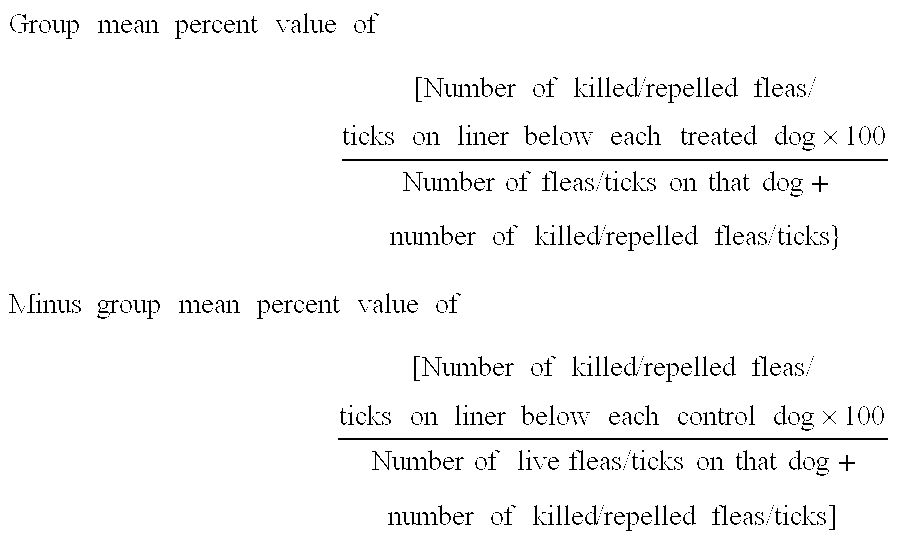Methods for Preventing Flea Allergy Dermatitis in Companion Animals
a technology for flea allergy dermatitis and companion animals, which is applied in the direction of biocide, antiparasitic agents, drug compositions, etc., can solve the problems of flea saliva allergy, rarely rectified, and a large amount of daily blood consumption, so as to prevent flea allergy dermatitis, and reduce the incidence of flea allergy dermatitis
- Summary
- Abstract
- Description
- Claims
- Application Information
AI Technical Summary
Benefits of technology
Problems solved by technology
Method used
Image
Examples
example 1
Method of Making a Cyphenothrin / IGR Spot-on Composition for Dogs
[0057]
IngredientConcentrationCyphenothrin20%Pyriproxyfen 2%Diethylene glycol monoethyl ether78%
[0058]The diethylene glycol monoethyl ether was charged to a vessel and heated to a temperature of 50° C. (about 1 hour). One heated, the cyphenothrin and pyriproxyfen were charged to the vessel and all components were mixed until a homogenous solution was formed (about 1 hour).
Example 2
Efficacy Evaluation of a Spot-on Composition Containing Fipronil and Cyphenothrin, Compared to Other Spot-on Compositions Against Fleas (Ctenocephalides Felis) and Ticks (Rhipicephalus sanguineus and Dermacentor variabilis) on Dogs
[0059]A cyphenothrin-fortified test substance containing 8.2% cyphenothrin and 9.8% fipronil was compared for efficacy to (1) a spot-on composition containing 5.2% cyphenothrin and 9.8% fipronil, (2) a spot-on composition containing 9.8% fipronil and 8.8% S-methoprene, (3) a spot-on composition containing 8.8% imidacl...
example 2
Immediate and Residual Efficacies Following Application of a Squeeze-on Containing Cyphenothrin and Pyriproxyfen and a Squeeze-on for Dogs Containing Fipronil and Cyphenothrin Compared with a Squeeze-on Containing Etofenprox, Methoprene and Piperonyl Butoxide, Against Fleas (Ctenocephalides felis) and Ticks (Rhipicephalus sanguineus and Dermacentor variabilis) on Dogs
[0096]A cyphenothrin-based test substance containing 20% cyphenothrin and 2% pyriproxyfen was compared for efficacy to (1) a squeeze-on composition containing 5.2% cyphenothrin and 9.8% fipronil, and (2) a squeeze-on composition containing 30% etofenprox, 5% piperonyl butoxide and 3.6% (s)-methoprene. Each composition was applied once, was evaluated and compared for efficacy against infestations of fleas and ticks (Rhipicephalus sanguineus and Dermacentor variabilis). Immediate efficacy against existing fleas and ticks and residual efficacies against flea and tick re-infestations, applied weekly, were measured over 37 d...
PUM
| Property | Measurement | Unit |
|---|---|---|
| Fraction | aaaaa | aaaaa |
| Fraction | aaaaa | aaaaa |
| Fraction | aaaaa | aaaaa |
Abstract
Description
Claims
Application Information
 Login to View More
Login to View More - R&D Engineer
- R&D Manager
- IP Professional
- Industry Leading Data Capabilities
- Powerful AI technology
- Patent DNA Extraction
Browse by: Latest US Patents, China's latest patents, Technical Efficacy Thesaurus, Application Domain, Technology Topic, Popular Technical Reports.
© 2024 PatSnap. All rights reserved.Legal|Privacy policy|Modern Slavery Act Transparency Statement|Sitemap|About US| Contact US: help@patsnap.com










